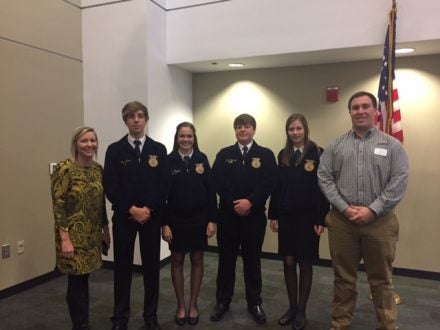FFA presents at November Chamber Connect
Published 4:59 pm Friday, November 3, 2017
With the Ag Appreciation Luncheon approaching next Friday, Decatur County Chamber of Commerce thought Thursday’s Chamber Connect Luncheon was a perfect time to hear from our local high school FFA chapter.
Members from Bainbridge High School’s FFA were in attendance, but four select students spoke to the crowd about all the things they were involved in.
Cayden Harrell was the first to speak; he introduced the first segment of the motto of FFA: learning to do, where students learn what to do to in order to prepare them for real life situations. Faith Taunton continued on the motto: doing to learn, where students take what they learn in class and put it into action. Sara Matthews introduced the third part of the motto: earning to live, where students earn career skills that will help them create a successful life in the future. Luke Jones introduced the final part of the motto: living to serve, where students live to give back to the community, because the community has given them the opportunity to be who they are today.
The students then presented some modules they learn about in the agriculture program. They first introduced agriculture leadership class. The students who participate in this class have done things such as; read books to second graders at Jones Wheat Elementary that have an agricultural theme. They believe this puts a small seed in young minds and helps them learn what Decatur County is all about. In addition they have worked alongside Salvation Army in order to give students a feel of being a leader.
Harrell showed various labs the students participate in, beginning with the poultry lab. In the poultry lab, students are taught how to process a fully-grown chicken and cut it with the various cuts that can be seen in the grocery store.
Matthews introduced the animal science lab, where students learn the different types of primal cuts they can make on the cow. They also learn the different tastes and textures that can come from the steaks produced by the cow.
Jones presented the wildlife management lab, where they worked on a project to create a sustainable ecosystem for the bass. They had a specialist come and shock the pond and do a reading on what types of fish were in the water along with other life forms that needed to be gotten rid of in order for the bass to survive. He also talked about the greenhouse that is upheld by the annual fern sale. The greenhouse teaches students how to take care of plants and make them marketable to buyers.
Harrell talked about a program called SAE, supervised agricultural experience that requires at least 20 hours and calls for record keeping.
“An ideal SAE would start their ninth grade year and continue through their senior year,” Harrell said.
One of the examples was a young lady, who now has twenty cow embryos.
Another program is called CDE, career development evaluation. They teach things such as electrification, where students can learn to wire basic household necessities. Another possibility is land evaluation, where students measure topsoil and see what the land could be used for- timber, farming or livestock.
Throughout all the different classes, FFA has given more to the students than anyone could ever imagine.
“FFA has had such a positive impact on my life by helping me to develop leadership skills and allowing me to be on the Parliamentary Procedure Team,” Matthews said. “It has given me career skills that I can use in my future career with animal science.”
Harrell agreed, “It has made a tremendous impact in my life by helping me become a better person, more responsible and through the different competitions I have overcome my fear of public speaking.”






